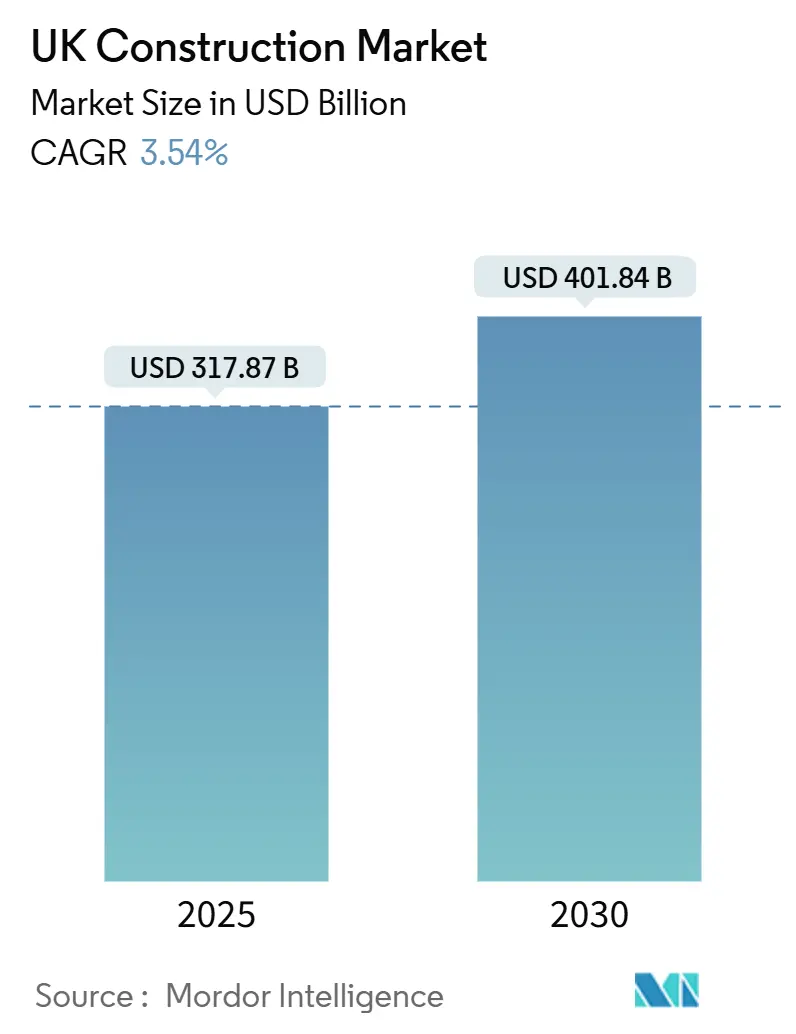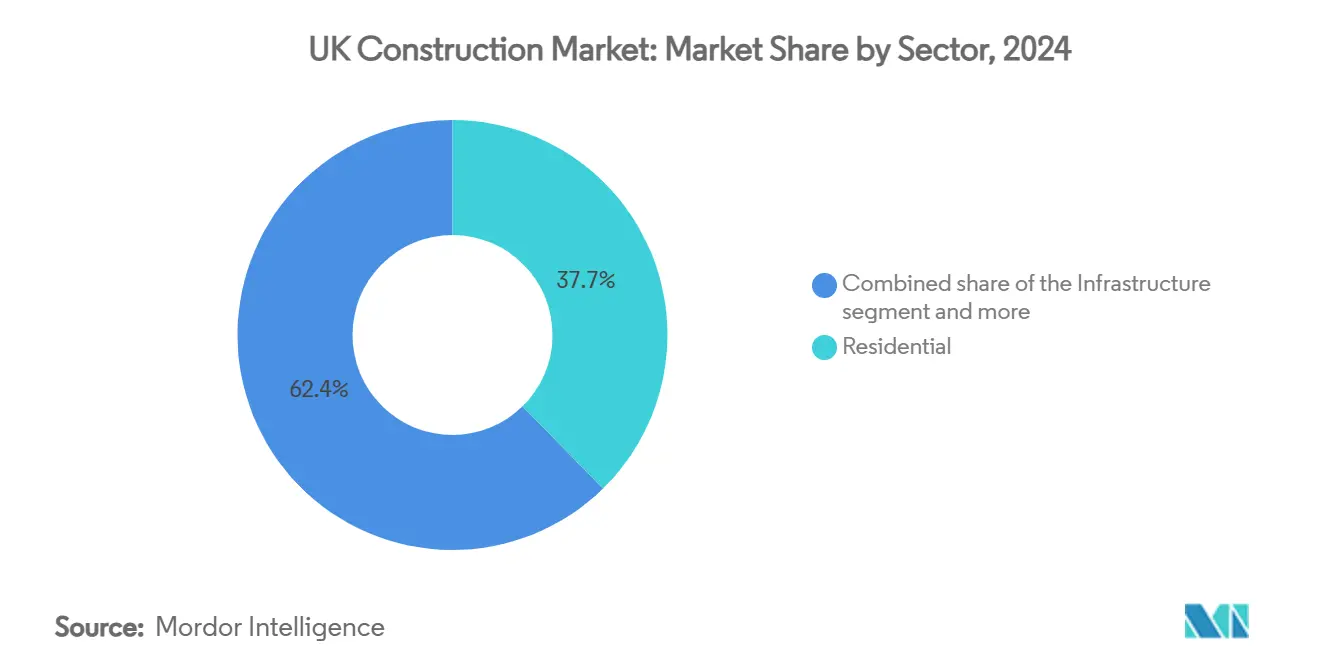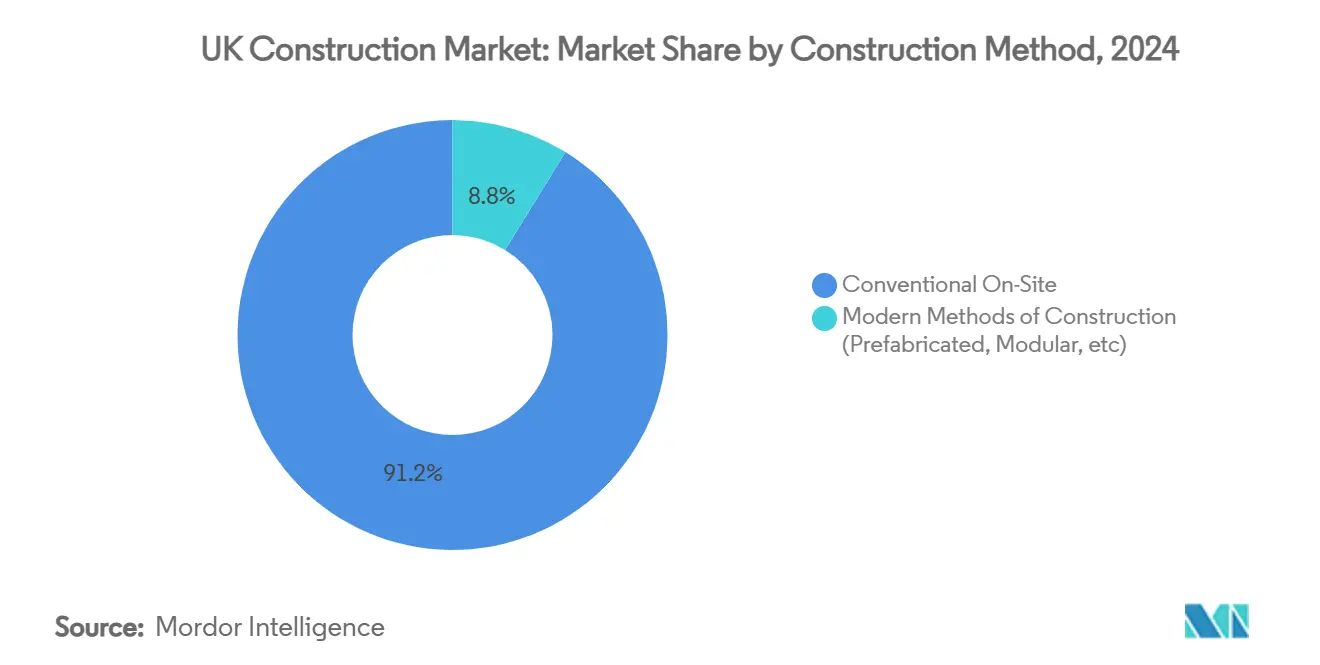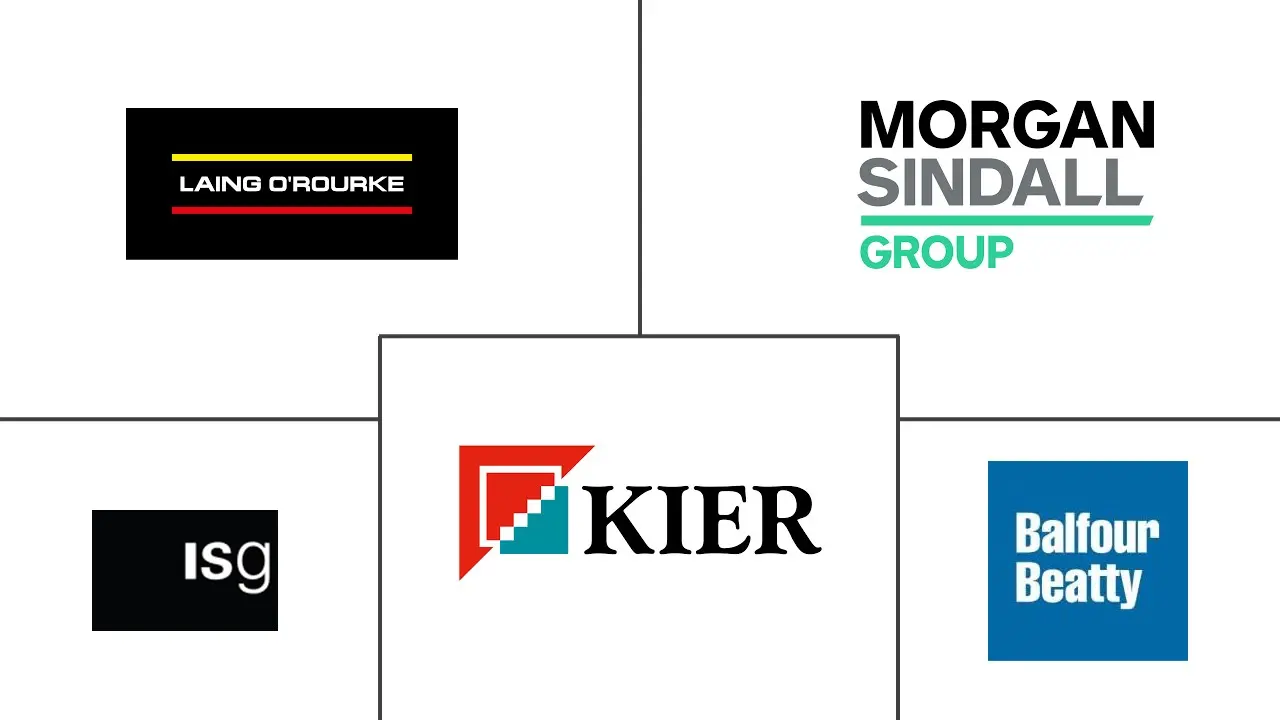
UK Construction Market Analysis by Mordor Intelligence
The UK Construction Market size is estimated at USD 317.87 billion in 2025, and is expected to reach USD 401.84 billion by 2030, at a CAGR of 3.54% during the forecast period (2025-2030).
A steady pipeline of transport and energy megaprojects, rising private-sector funding commitments, and evolving safety and sustainability regulations underpin this forward trajectory. Government outlays tied to the USD 213.2 billion National Infrastructure Pipeline and the USD 105.3 billion HS2 program sustain contractor order books, while pension-fund capital unlocked by the Mansion House Accord broadens the investor base. Housing demand that exceeds current delivery by an estimated 340,000 units per year keeps residential starts elevated even as infrastructure leads growth. Meanwhile, the Building Safety Act accelerates retrofit demand across existing assets, and digital design tools sharpen delivery efficiency, allowing firms to absorb lingering material-price volatility and skilled-labor tightness.
Key Report Takeaways
- By sector, residential accounted for 37.65% of the United Kingdom construction market size in 2024, while infrastructure is expected to post the highest 7.8% CAGR to 2030.
- By construction type, new-build activity held 54.7% share of the United Kingdom construction market size in 2024; renovation and retrofit are advancing at a 7.0% CAGR through 2030.
- By construction method, conventional on-site techniques retained a 91.2% share of 2024 in the UK Construction Industry, whereas Modern Methods of Construction are set to expand at a 10.0% CAGR.
- By investment source, private capital supplied 74.8% of 2024 spending and is forecast to rise at a 7.9% CAGR, outpacing public-sector outlays.
- By Geography, England led with 78.5% of the United Kingdom construction market share in 2024; Northern Ireland is projected to register the fastest 5.9% CAGR through 2030.
UK Construction Market Trends and Insights
Drivers Impact Analysis
| Driver | (%) Impact on CAGR Forecast | Geographic Relevance | Impact Timeline |
|---|---|---|---|
| Government megaprojects (HS2, RIS2) | +1.2% | England core; spill-over to Wales & Scotland | Long term (≥ 4 years) |
| Chronic housing shortfall | +0.8% | National; early gains in London, Manchester, Birmingham | Medium term (2-4 years) |
| Net-Zero 2050 retrofit push | +0.6% | National; quicker in England & Scotland | Long term (≥ 4 years) |
| Off-site & modular uptake post-Safety Act | +0.4% | England & Wales | Medium term (2-4 years) |
| Infrastructure secondary-market M&A | +0.3% | National; major urban centers | Short term (≤ 2 years) |
| Digital-twin adoption | +0.2% | National; led by large contractors | Medium term (2-4 years) |
| Source: Mordor Intelligence | |||
Government Mega-Projects Drive Civil-Engineering Renaissance
Sustained outlays on HS2 and the Road Investment Strategy 2 inject long-range certainty into the United Kingdom construction market. HS2 alone supports more than 31,000 on-site roles across 350 work fronts, with 70% of twin-bore tunneling already finished and 58% of earthworks in place as of 2024. The scale, valued at USD 105.3 billion, keeps tier-1 contractors such as Balfour Beatty and Kier Group positioned for multi-decade revenue flows. Supply-chain specialization in high-speed rail systems, tunneling, and digital construction methods spills into adjacent sectors, broadening competence clusters nationwide. As RIS2 road upgrades move in tandem, the civil-engineering backlog remains robust, stabilizing employment and investment across England while catalyzing technology adoption that ultimately diffuses to Wales and Scotland.
Housing Crisis Intensifies Residential Construction Urgency
Structural demand for 340,000 homes per year reinforces residential activity as a key pillar of the United Kingdom construction market. Planned delivery of 1.5 million units by 2029 faces an acute skills gap that requires an estimated 30,000 new workers for every 10,000 dwellings. Yet the shortfall sparks innovation: modular builders pledge 20,000 low-carbon homes by 2025 that are assembled 50% quicker and operate at 55% lower heating cost[1]Make UK Modular, “Modular Housing Delivery Roadmap 2024,” makeuk.org. Planning-system reform seeks to streamline approvals, but progress depends on parallel investments in training and digital permitting. Overall, unmet demand translates into steady residential starts that support material suppliers and keep smaller subcontractors engaged despite broader economic headwinds[2]Construction Leadership Council, “National Retrofit Strategy,” constructionleadershipcouncil.co.uk.
Net-Zero Mandates Accelerate Green Retrofit Revolution
National decarbonization goals push retrofit volumes upward, shaping new revenue pools across the United Kingdom construction market. The Construction Leadership Council’s USD 682.5 billion National Retrofit Strategy targets 500,000 jobs over two decades. All new homes must meet next-generation efficiency codes by 2025, while the pilot UK Net Zero Carbon Buildings Standard sets unified metrics for commercial, residential, and educational facilities. Contractors able to quantify embodied carbon and integrate heat-pump, insulation, and smart-control solutions gain a competitive edge. As utility costs escalate, landlords and occupiers increasingly view energy upgrades as economic imperatives, accelerating order books for façade improvements and mechanical retrofits.
Building Safety Act Catalyzes Off-Site Construction Adoption
Post-Grenfell regulations have tightened accountability and documentation thresholds, steering developers toward factory-controlled environments that guarantee repeatable quality. The Building Safety Act applies rigorous oversight to structures taller than 18 meters or seven stories, raising compliance risk for conventional on-site builds. Resulting demand lifts off-site penetration from 9% in 2017 to 16% in 2023. Government incentives through the USD 14.95 billion Affordable Homes Program promote volumetric and panelized systems that cut waste and shrink schedules. While up-front coordination is heavier, early adopters report life-cycle productivity gains that offset capital cost premiums, reinforcing a virtuous cycle for modular growth across education, healthcare, and multi-family segments.
Restraint Impact Analysis
| Restraint | (%) Impact on CAGR Forecast | Geographic Relevance | Impact Timeline |
|---|---|---|---|
| Skilled-labor shortage & aging workforce | −0.9% | National; acute in London & South East | Medium term (2-4 years) |
| Material-price volatility & supply chains | −0.6% | National; regional variations | Short term (≤ 2 years) |
| Planning & permitting delays | −0.4% | England & Wales | Medium term (2-4 years) |
| Cybersecurity risks in BIM projects | −0.2% | National, major projects | Long term (≥ 4 years) |
| Source: Mordor Intelligence | |||
Demographic Crisis Threatens Industry Sustainability
The United Kingdom construction industry faces the loss of roughly 50,000 workers annually, a trend that slices capacity just as megaproject demand peaks. Apprenticeship dropout rates above 40% and limited EU labor mobility post-Brexit widen the gap, while an aging cohort means half a million retirements loom within 15 years. Wage inflation has yet to lure sufficient entrants into skilled trades such as bricklaying and civil engineering. Contractors, therefore, adopt productivity-enhancing technologies and off-site fabrication to stretch limited manpower, but chronic shortages still tighten project schedules and dampen tender appetite, limiting the upside for the United Kingdom construction market.
Material Cost Volatility Undermines Project Economics
Aggregate construction material prices have climbed 38% since 2020, forcing contractors to build larger contingencies that erode bid competitiveness. Bricks buck the broader stabilization trend, with 2024 deliveries up 19% year-over-year, whereas cement output fell 8.4% and aggregates volumes softened. Global shipping bottlenecks and exchange-rate swings inject further unpredictability, leading to contract renegotiations and re-sequencing of activities to hedge exposure. Smaller firms with thin balance sheets struggle most, occasionally exiting projects mid-cycle, which raises completion risk and pushes clients toward larger players, altering competitive dynamics within the United Kingdom construction market[3]Department for Business & Trade, “UK Construction Material Price Index 2024,” gov.uk.
Segment Analysis
By Sector: Infrastructure Emerges as Growth Engine
Infrastructure starts hold a 7.8% CAGR through 2030, surpassing every other vertical within the United Kingdom construction market. Rail, road, and grid programs anchored by HS2 and the National Infrastructure Pipeline open multi-year spending windows that offset cyclicality in private real estate. The sector enjoys political consensus because improved connectivity underpins productivity and regional leveling-up ambitions. Energy infrastructure accelerates as offshore wind build-out and grid reinforcement align with Net-Zero commitments, inviting joint ventures between civil contractors and specialist energy firms.
Residential, despite leading in 2024 with 37.65%, advances at a measured pace, such as planning bottlenecks and mortgage-rate swings, temper growth. Commercial office work remains selective, focusing on prime ESG-compliant assets, while industrial and logistics shed face tailwinds from e-commerce. The diverging performance underscores the shift toward infrastructure as the primary volume driver of the United Kingdom construction market.

Note: Segment shares of all individual segments available upon report purchase
By Construction Type: Renovation Gains Momentum
New construction contributed 54.7% to the United Kingdom construction market size in 2024, but renovation’s 7.0% CAGR signals shifting priorities. Safety-driven cladding remediation, fire-stopping upgrades, and energy retrofits dominate tender lists as owners confront retrospective liability windows up to 30 years under the Building Safety Act. Retrofit work requires different phasing and tenant engagement strategies, favoring contractors adept at live-environment delivery.
Government levies are expected to collect USD 4.42 billion over a decade to fund safety remedial grants, and innovative financing, such as green mortgages, underwrites energy-efficient upgrades. Combined, these measures expand the renovation pipeline while preserving a healthy base for new-build housing and infrastructure.
By Construction Method: Modern Methods Gain Traction
Conventional on-site approaches still secure 91.2% of the 2024 value, yet the 10.0% CAGR for MMC reveals mounting momentum. Factory precision, shorter build cycles, and tighter quality control resonate with developers navigating labor scarcity and higher compliance thresholds. Studies by the Ministry of Housing, Communities & Local Government indicate volumetric modular projects can cut program durations by 20% while reducing waste by 45%.
Adoption spreads from student housing and schools to high-rise residential, where standardized bathroom pods and façades lift speed without compromising aesthetics. Challenges persist around fire-safety detailing and warranty acceptance, but collaborative design frameworks lower risk, positioning MMC as a core modernization lever within the United Kingdom construction market.

By Investment Source: Private Capital Dominance Intensifies
Private investors funded 74.8% of construction outlays in 2024 and exhibit the strongest 7.9% growth path. The USD 65 billion commitment under the Mansion House Accord channels pension assets toward domestic infrastructure, offering inflation-linked returns that match liability profiles. BlackRock’s USD 12.5 billion acquisition of Global Infrastructure Partners underscores global appetite for UK assets.
Public budgets remain essential for social housing and strategic defense facilities, yet fiscal-rule constraints cap expansion. Structured partnerships, regulated-asset-based models, and user-charge mechanisms increasingly bridge the gap, sustaining a pipeline attractive to institutional capital and reinforcing private-sector primacy in shaping the United Kingdom construction market.
Geography Analysis
England retains 78.5% share of the United Kingdom construction market, a reflection of London’s financial center, the South-East’s logistics corridors, and large transport schemes such as Crossrail and HS2 Phase 1. High land values and tight labor pools temper incremental growth, but ongoing regeneration, build-to-rent towers, and hospital upgrades preserve volume. Regional devolution deals foster city-region investment plans that channel funds into Birmingham’s Curzon Street HS2 hub and Manchester’s Mayfield redevelopment, broadening England’s project mix.
Scotland commands a smaller base yet benefits from renewable-energy infrastructure. Port upgrades at Nigg and transmission projects aligned with North Sea wind farms attract specialized marine-civil contractors. Additionally, the Scottish Government’s commitment to a 75% emissions cut by 2030 accelerates low-carbon public-sector builds. Wales charts growth through the South Wales Metro and valley housing refurbishments, exploiting its proximity to Irish Sea shipping lanes.
Northern Ireland, with the fastest 5.9% CAGR, capitalizes on EU-replacement funds that underpin road and digital-connectivity upgrades. Its unique access to both UK and EU regulatory spheres lures manufacturers to reshore supply chains, boosting demand for industrial-unit construction. Cross-border trade with the Republic of Ireland stimulates warehousing around Belfast and Newry, while tourism-oriented hospitality refurbishments benefit from favorable sterling exchange rates. Altogether, regional divergence offers contractors diversified entry points, mitigating concentration risk inherent in an England-centric project portfolio.
Competitive Landscape
The United Kingdom construction market shows moderate fragmentation: the top five firms control about 28% of revenue, while hundreds of regional contractors compete for mid-size projects. Balfour Beatty’s USD 21.58 billion order book spans transport, energy, and defense, helping it record 6% profit growth in 2024. Kier Group’s turnaround produced USD 5.16 billion in revenue and doubled net cash, aided by the purchase of Buckingham Group’s rail assets.
Mid-tier companies struggle with material-cost swings and bonding capacity, but differentiate through local networks and specialist niches such as heritage restoration. Digital-twin deployments on projects like Heathrow Terminal 5 demonstrate the efficiency gains that larger players leverage to win framework agreements. Sustainability credentials also influence bidding success; tier-1 firms increasingly publish science-based decarbonization targets to satisfy client procurement criteria.
Modern Methods of Construction invite new entrants, including manufacturing-led consortia, yet high up-front capital favors collaborations with established contractors. Compliance demands embedded in the Building Safety Act further raise administrative overhead, nudging smaller players into joint ventures or acquisition targets. Overall, the competitive environment rewards scale, risk-management maturity, and technology fluency, even as niche specialists retain space for high-skill, low-volume assignments.
UK Construction Industry Leaders
Balfour Beatty PLC
Kier Group PLC
Morgan Sindall Group PLC
Laing O'Rourke PLC
ISG PLC
- *Disclaimer: Major Players sorted in no particular order



Recent Industry Developments
- July 2025: Anglian Water appointed AtkinsRéalis, Mace, and Turner & Townsend to deliver its USD 14.3 billion five-year capital program, forming one of the UK’s largest infrastructure alliances.
- February 2025: KKR tabled a USD 5.2 billion buyout proposal for Thames Water, aiming to stabilize operations amid a USD 20.8 billion debt load.
- January 2025: United Utilities chose the Strabag-Equitix venture for the Haweswater Aqueduct modernization, reinforcing Continental contractors’ profile in UK water projects.
- June 2024: Balfour Beatty secured a USD 249.6 million contract to construct three substations supporting Scottish renewable-energy integration.
UK Construction Market Report Scope
Construction is the installation, maintenance, and repair of buildings and other stationary structures, as well as the construction of roadways and service facilities that form fundamental components of structures and are required for their operation. Construction encompasses the processes involved in constructing buildings, infrastructure, industrial facilities, and related operations from start to finish. A complete background analysis of the UK construction market, including an assessment of the economy and contribution of sectors in the economy, market overview, market size estimation for key segments, and emerging trends in the market segments, market dynamics, and geographical trends, and the COVID-19 pandemic’s impact, is covered in the report.
The UK construction market is segmented by sector (residential, commercial, industrial, infrastructure, and energy and utilities) and key regions (England, Northern Ireland, Scotland, and Wales). The report offers market sizes and forecasts for all the above segments in value (USD).
| Residential | Apartments/Condominiums |
| Villas/Landed Houses | |
| Commercial | Office |
| Retail | |
| Industrial and Logistics | |
| Others | |
| Infrastructure | Transportation Infrastructure (Roadways, Railways, Airways, others) |
| Energy & Utilities | |
| Others |
| New Construction |
| Renovation |
| Conventional On-Site |
| Modern Methods of Construction (Prefabricated, Modular, etc) |
| Public |
| Private |
| England |
| Scotland |
| Wales |
| Northern Ireland |
| By Sector | Residential | Apartments/Condominiums |
| Villas/Landed Houses | ||
| Commercial | Office | |
| Retail | ||
| Industrial and Logistics | ||
| Others | ||
| Infrastructure | Transportation Infrastructure (Roadways, Railways, Airways, others) | |
| Energy & Utilities | ||
| Others | ||
| By Construction Type | New Construction | |
| Renovation | ||
| By Construction Method | Conventional On-Site | |
| Modern Methods of Construction (Prefabricated, Modular, etc) | ||
| By Investment Source | Public | |
| Private | ||
| By Geography | England | |
| Scotland | ||
| Wales | ||
| Northern Ireland | ||


Key Questions Answered in the Report
How large is the United Kingdom construction market in 2025?
The market is valued at USD 317.87 billion in 2025 and is projected to reach USD 401.84 billion by 2030.
Which segment is growing fastest within UK construction?
Infrastructure leads with a 7.8% CAGR thanks to rail, road, and energy megaprojects.
Why is private capital important to UK construction funding?
Private investors now finance 74.8% of total spending and are expanding at a 7.9% CAGR, aided by pension-fund reforms.
What impact does the Building Safety Act have on project delivery?
The Act tightens compliance for high-rise buildings, accelerating demand for off-site construction and retrofit services that better document safety standards.
Page last updated on:








